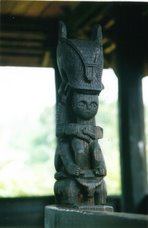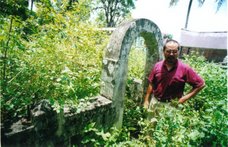
The old police station where Teluk Mak Intan was founded.
Pic by Khoo Salma Nasution
Teluk Intan, A Perak Town Named After A Mandailing Woman
By Abdur-Razzaq Lubis
Teluk Intan is a moderate sized town in the state of Perak, Malaysia. With an estimated population of around 110,000, Teluk Itan is the largest town in the district of Lower Perak and third largest in the state of Perak.
The town was founded on the bank of the Perak River. The river forms an omega-shaped oxbow, and the town is built in the loop of the oxbow. During high-tide, some parts of the town tends to flood even though there are watergates and protective banks.
Historically, it was known as Teluk Mak Intan (Mak Intan’s Bay) or Pekan Mak Intan (Mak Intan’s Town), taking its name from a noble and wealthy Mandailing woman, in which case, she would have been a family member of the Namora-Natoras (The Noble [and] The Elders), the Mandailing elite.
In view of her social and financial standing, it is plausible that she would have been the patron of the traders at Teluk Mak Intan. The existence of Teluk Mak Intan has been recorded since the late 19th century. Oral tradition has it that Teluk Mak Intan was established after Batak Rabit and Durian Sebatang. The original site of Teluk Mak Intan is the old police station (Balai Polis) and its vicinity.
As for the origin of the name Teluk Mak Intan, oral history narrates an incident in which Mak Intan was swimming and frolicking with her friends and attendants at a bay on the lower reaches of the Perak River, when her diamond studded hair pin, a gift from her parents, which held her bun together, fell into the river and was never recovered. Over time, when recalling the incident, people referred to the place where she dropped her hair pin as Teluk Mak Intan.
Compared to Durian Sebatang or Batak Rabit on the banks of the Perak river, Teluk Mak Intan was then free of floods, its bank secure and the bay deep, making it a suitable river port and commercial centre. On top of that, its hinterland was fertile for tubers, corn, bananas and the likes.
Therefore it comes as no surprise that it was also known as Pekan Mak Intan as it was a staging point for sojourners and traders from the Indonesian archipelago and other parts of the globe, who wanted to trade with the interior of Perak.
Traders from Kampar brought black cloth, shrimp paste (belacan), white silk, batik (kain rawa), tobacco, palm thatch (attap nipah) and salted or pickled fish (ikan peda,ikan pekasam) for sale. On their return journey they carried tin.
Sumatran sojourners and traders from Batak, Batu Bara, Kampar, Kerinci, Mandailing dan Selayang ethnic groups as well as Bugis seamen from the island of Sulawesi (Celebes), would go upstream to Batu Gajah in the Kinta Valley, in the interior of Perak state, through the port of Teluk Mak Intan.
“Mereka datang menaiki sampan atau sekoci, perahu dan lading melalui muara Sungai Perak menuju terus ke sungai Kinta membawa barangan keperluan pelombong [penambang] dan penduduk kampung. Perjalanan dari Teluk Anson (Teluk Intan) ke Batu Gajah [pemukiman di Lembah Kinta] biasanya memakan masa empat hingga lima hari.”
(They came in sampan or sekoci, perahu or lading through the estuary of the Perak river, heading straight to the Kinta river carrying with them the provisions for miners and villagers. The journey from Teluk Intan to Batu Gajah usually takes between four to five days.”
During British colonial rule, the third British Resident to Perak, Hugh Low, proposed,
“a plan of such a town as might be built in Teluk Malunting. [Teluk Mak Intan]. I [Hugh Low] would then propose that all the Chinese who have built on the point at During Sebatang should be bound to remove to the more favourable place… I would insist on this. The Customs house, the court house, landing jetty and chief police station should be put there at once. I will send the plan and write on the subject to Singapore as soon as I can…”
The superior geographical location of Teluk Mak Intan compared to other locations in Lower Perak made it a suitable candidate for a new administrative centre in the district. Hugh Low's proposal was enthusiastically received by the acting Governor of the Straits Settlements (at the time the Federated Malay States has yet to be instituted), Col. Archibald Anson (1879-1880), the latter even drew the first plans for the town.
Accordingly, in a State Council meeting of 15 March 1882, Hugh Low recommended that,
“…the new Settlement at Telok Ma’ Hitam [Teluk Mak Intan]… be known as ‘Telok Anson’, in compliment to General Anson, who drew the first plan of the town and took great interest in its removal from Durian Sebatang. The name Telok Ma’ Hitam has also been found inconveniently long.”
The recommendation was unanimously accepted by the Council, which officially changed the name of Telok Mak Intan to Telok Anson (literally, Anson’s Bay), or in Chinese 安顺 (Pinyin: Ānshùn).
During its centenary celebrations in 1982, the Sultan of Perak partially reverted the name of the town to Teluk Intan, dropping the feminine Mak. Teluk Intan served as the major administrative and business settlement for smaller neighbouring towns such as Tapah, Bidor, Bagan Datoh and Hutan Melintang. The town has a number of colonial buildings and Chinese shophouses together with modern buildings and a few shopping complexes and educational institutions. Being the major town in Hilir Perak and nearby smaller townships, Teluk Intan attracts shoppers from the surrounding area. Shopping and food brings many people to Teluk Intan during the weekends.
The main economic activities in Lower Perak around Teluk Intan today are oil palm cultivation and palm oil production. Some of the big corporations owning plantations around Teluk Intan, are United Plantations (UP), Golden Hope Plantations, Sime Darby and Kumpulan Guthrie Berhad.


No comments:
Post a Comment